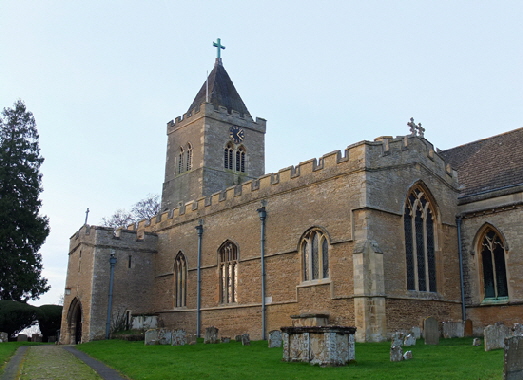|
|
|
||||||||||||||
|
|
|
The nave east of the old Anglo-Danish fabric and the chancel all date from only 1852-4. It was ll built around the Mordaunt tombs, however, and we can see from the mediaeval triple sedilia and piscina on the south side of the chancel that all was not wantonly destroyed here. There is little known about the chancel prior to this date. The south door is striking and, remarkably, is thirteenth century so presumably contemporary with the south aisle itself. The ironwork, especially the two iron door handles which are beautifully integrated into the iron strapwork. The metalworker that wrought this lovely work is believed to have been one “John of Leighton” who provided the iron grille on the tomb of Queen Eleanor in Westminster Abbey. There are other examples in Eaton Bray and Leighton Buzzard churches, also in Bedfordshire. Other treasures here are a fourteenth century wall painting of the crucifixion and the chunky thirteenth century font. Pevsner suggested that the legs are more in the Norman style and suggests a possible date of 1200. The Mordaunt monuments, however, are the big draw here. There are four in all.l |
 |
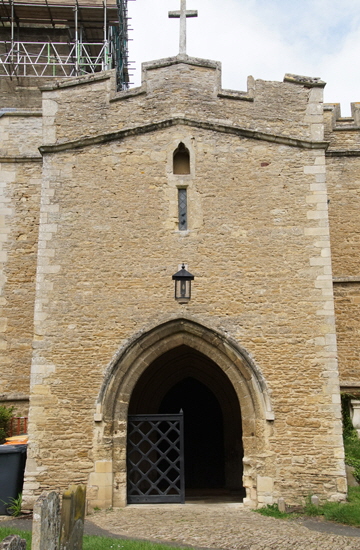 |
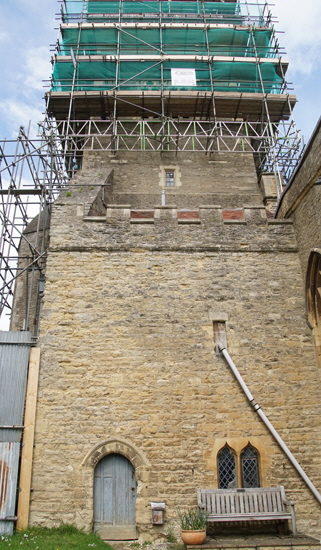 |
||||||||||||||||||||||||||||||||||||||||||||||||
|
Left: The magnificent thirteenth century south door. Centre: The fortress-like south porch. Right: As you can see, I visited at a time when extensive work was being done on the west tower (my title picture is courtesy of Bonnie Herrick who was here the previous year) seen here from the south side |
||||||||||||||||||||||||||||||||||||||||||||||||||
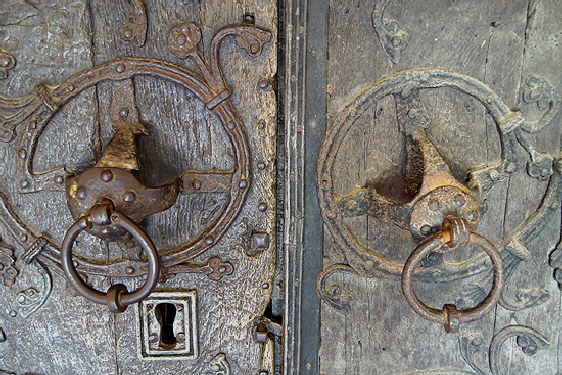 |
 |
|||||||||||||||||||||||||||||||||||||||||||||||||
|
Left: The wonderful original iron handles of the south door. Note the way that they are artfully integrated into the decorative design. Right: The south wall of the nave shows the remnants of two windows of the nave of the original Anglo-Saxon nave wall. |
||||||||||||||||||||||||||||||||||||||||||||||||||
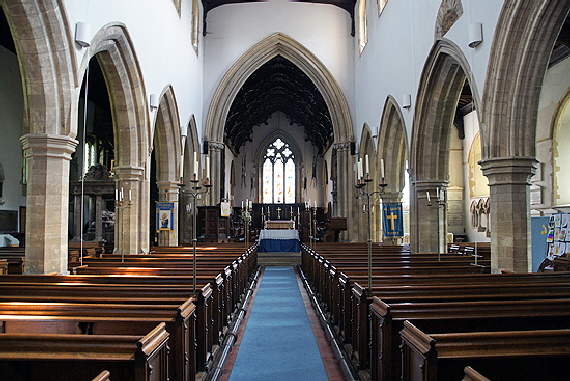 |
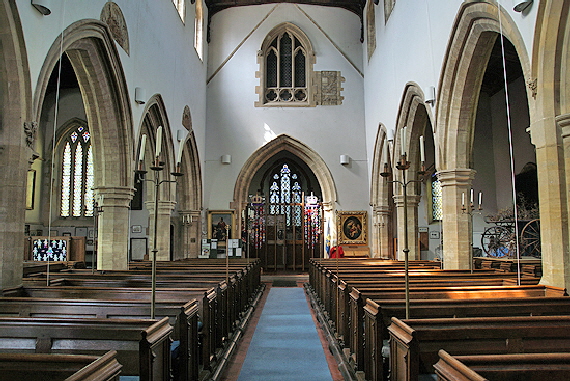 |
|||||||||||||||||||||||||||||||||||||||||||||||||
|
Left: Looking towards the east. The sat window has its original tracery. Right: Looking towards the west. Note to the left and right the more solid columns of the aisles which must mark the easternmost limits of the Anglo-Saxon nave. You can see an earlier roofline of the church. I do not think this is the roofline of the Anglo-Saxon church. The heads of the blocked windows would be too close to the horizontal roofline. Similarly the filled in doorway of the west wall which is a typical Anglo-Saxon feature. The tower arch is thirteenth century in keeping with the tower itself but somewhat altered. |
||||||||||||||||||||||||||||||||||||||||||||||||||
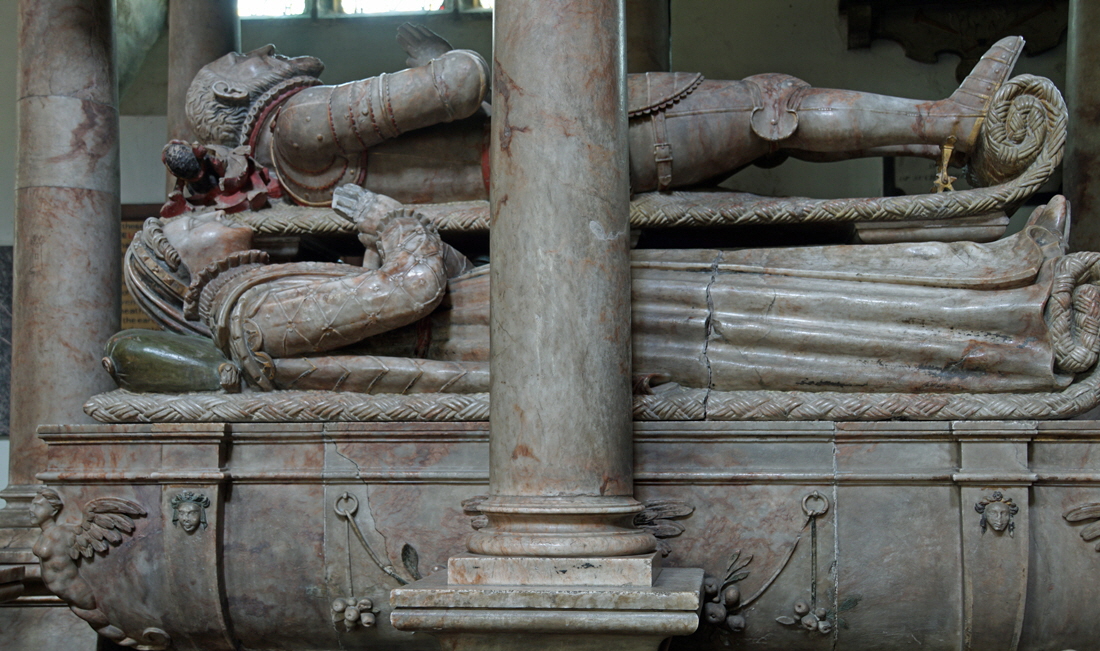 |
||||||||||||||||||||||||||||||||||||||||||||||||||
|
The finest of the Mordaunt monuments, to John the 2nd Lord Mordaunt (1508-71). It is in a mortuary chapel located between the three western bays of the north aisle to the east and the organ chamber to the east. This monument - of alabaster - created in 1571, is most unusual. John is accompanied by his two wives Eleanor Fitz Lewis and Joan Farmer. Two wives was not unusual when women were so vulnerable to perinatal death and when rich widowers were apt to marry young replacements. What is unusual is that the two women are on either side of him (so one wife is hidden in this picture) rather than the more common arrangement of the two wives being stacked below him as seen in, for example, Swinbrook in Oxfordshire. John was a prominent member of Henry VIII’s court, MP, member of the House of Lords and Sheriff of both Essex and Hertfordshire. Under Mary Tudor he was a member of her Council and active in suppressing the new Protestantism. He had the shudder-inducing role of “heresy commissioner” in his portfolio. He was duly consigned to the Fleet prison by Elizabeth I, probably only briefly. Sadly. Note his spurs. |
||||||||||||||||||||||||||||||||||||||||||||||||||
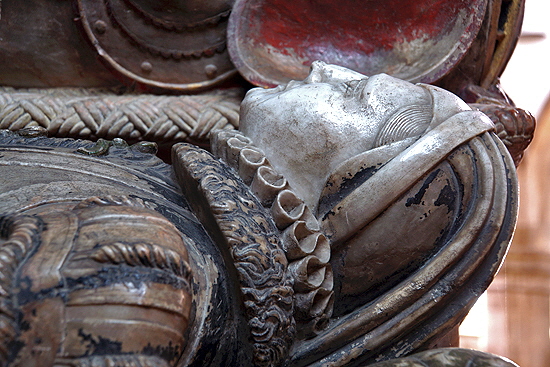 |
||||||||||||||||||||||||||||||||||||||||||||||||||
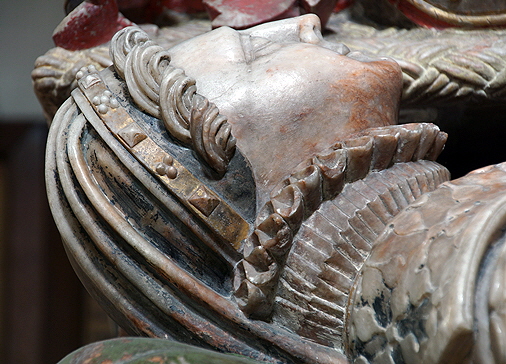 |
||||||||||||||||||||||||||||||||||||||||||||||||||
|
The Two Wives of John Mordaunt does not quite have the same ring as the Six Wives of Henry VIII, but here are the two ladies. Left: Ellen FitzLewis (1522-43) . Right: Joan Farmer.(or “Fermor”. |
||||||||||||||||||||||||||||||||||||||||||||||||||
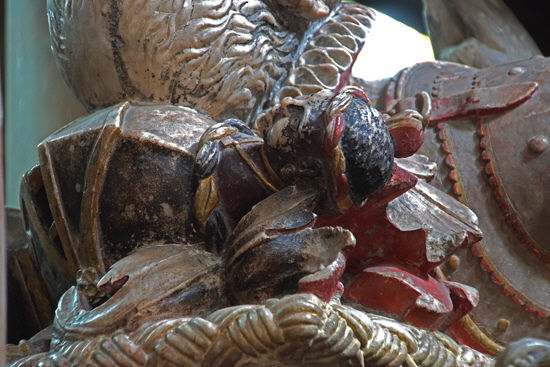 |
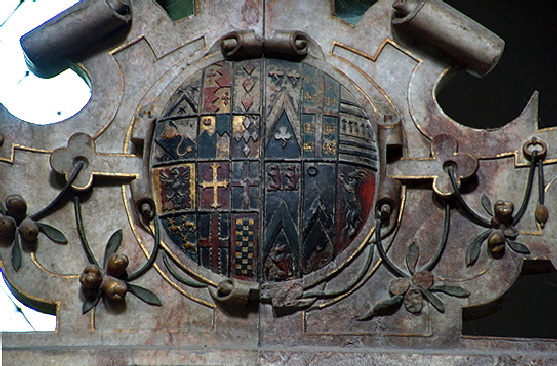 |
|||||||||||||||||||||||||||||||||||||||||||||||||
|
Left: A very interesting detail. This is taken from behind John’s head. This appears to be a saracen’s head - “saracen” being that all-purpose term for any scimitar-wielding “heathen” of the Middle East, harking back to the Crusades. Such imagery was anachronistic by now, centuries after the last crusade, but it lingered on. You can see another example on one of the Lovell family monuments at East Harling in Norfolk. One imagines it was a an affirmation of the man’s devotion to Christianity, a willingness (perish the thought) to have taken up arms if only he had been called! Right: The arms above the monument with its display of the many families to which the the Mordaunts were related. |
||||||||||||||||||||||||||||||||||||||||||||||||||
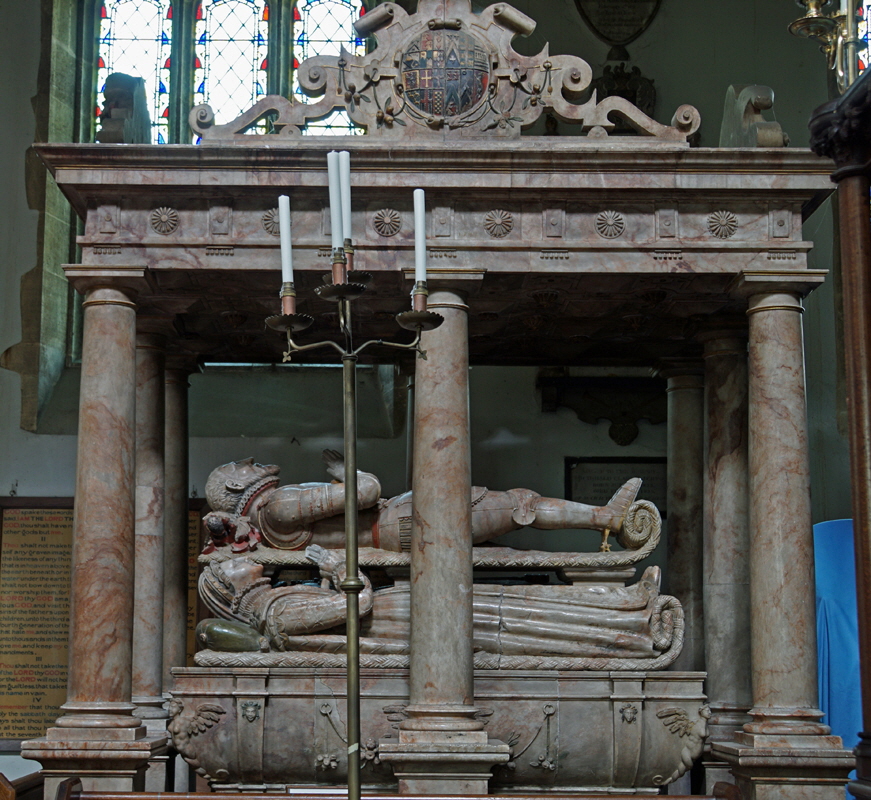 |
||||||||||||||||||||||||||||||||||||||||||||||||||
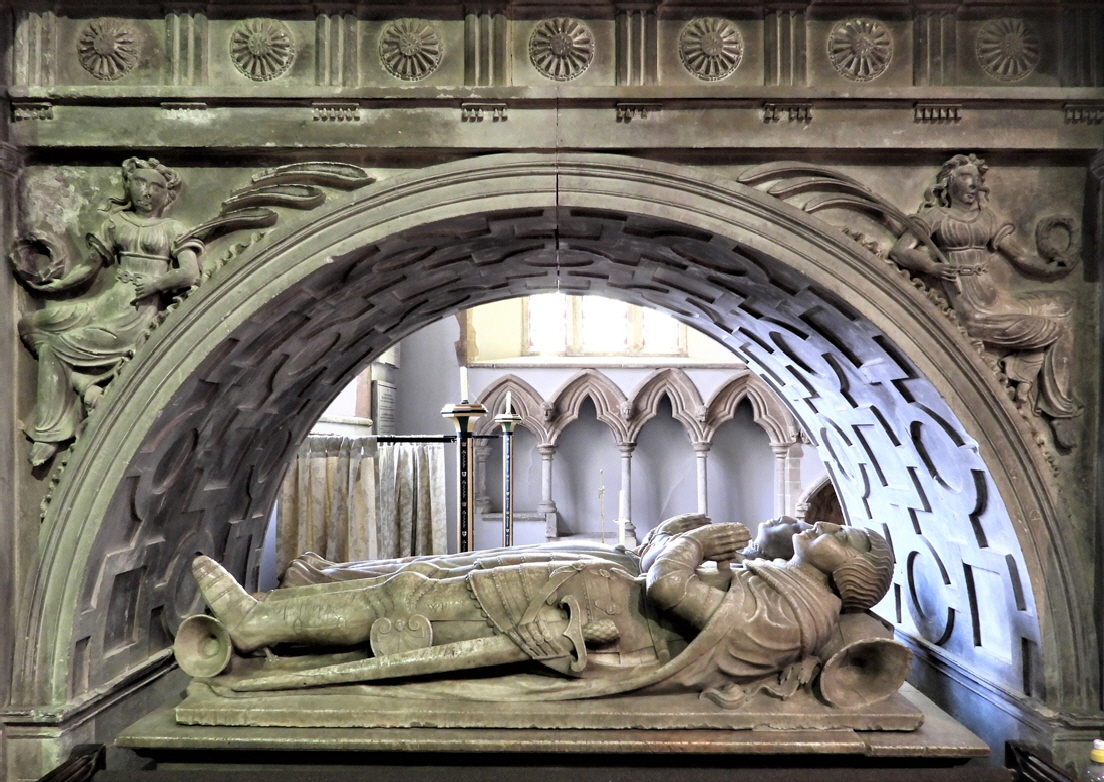 |
||||||||||||||||||||||||||||||||||||||||||||||||||
|
The monument of the 1st Lord Mordaunt 1483-1561, also a John, and his wife, Elizabeth Vere. The effigies are in alabaster, but the surround is of stone. The carver is believed to be Thomas Kirby. John also served Henry VIII, attending him at the Field of the Cloth of Gold and a sometime member of his Council. He was created the first Baron in 1532 and thereafter a member of the House of Lords. He must have been somewhat more judicious in his religious leanings than his son because he managed to hold a few posts under the protestant teenage King Edward VI. He looks quite serene. Note the absence of a ruff around his neck, and a rather less militaristic look than his son, his armour softened by the wearing of a cloak. The monument is located between the chancel and the south aisle. This picture is taken from the north, looking into the aisle. (Photo: Bonnie Herrick) |
||||||||||||||||||||||||||||||||||||||||||||||||||
 |
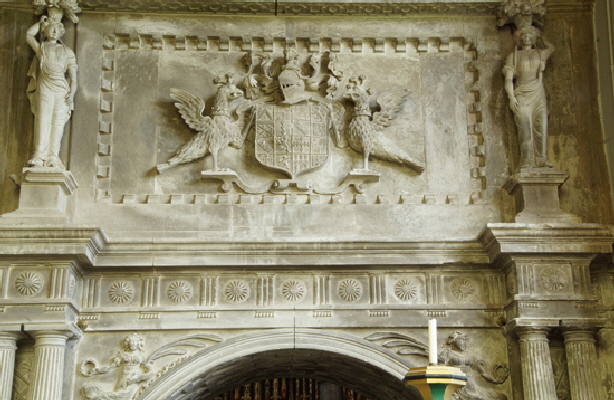 |
|||||||||||||||||||||||||||||||||||||||||||||||||
|
Left: The monument from the south west. (Photo: Bonnie Herrick) Right: The top of the monument from the north. The star-like roundels is a device shared by his son’s tomb. The classical allusions either side of the arch to the tomb and the caryatids are far more flamboyant than anything on his son’s altogether more dark and austere monument. For comparison look at the coats of arms. |
||||||||||||||||||||||||||||||||||||||||||||||||||
 |
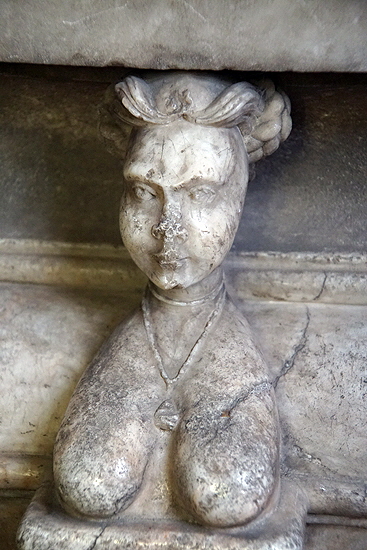 |
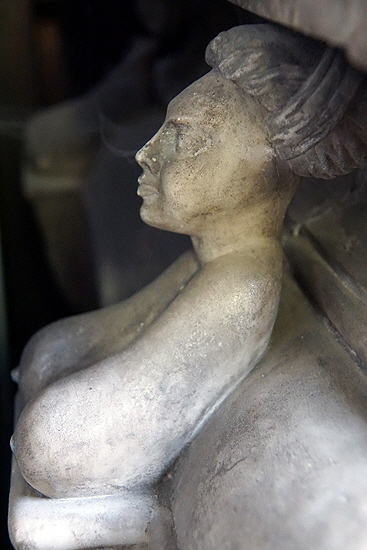 |
||||||||||||||||||||||||||||||||||||||||||||||||
|
These sculptures form part of the monument. They are quite extraordinary. They are presumably the couple’s children and one even shows a jewellery pendant. There is no suggestion of weeping and wailing and the design has what is I am sure an unintended effect of making them look like a line of bare-breasted women! In fact, until I saw that the left hand figure had facial hair I thought that was what they were! Perhaps they are supposed to depict arms? |
||||||||||||||||||||||||||||||||||||||||||||||||||
 |
||||||||||||||||||||||||||||||||||||||||||||||||||
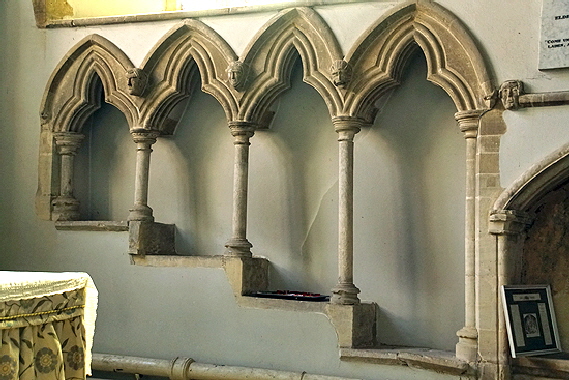 |
||||||||||||||||||||||||||||||||||||||||||||||||||
|
Left: John and Elizabeth, still praying for salvation after all these years. Right: The triple sedilia and piscina is an impressive combination, supposedly thirteenth century. It seems I am the only person who thinks it is also deeply weird. The sub-deacon would have his knees up around his jaw and the priest would be doing a little jump to get into his seat and in doing so would probably crack his skull. And although it is a nice composition architecturally it is also very badly executed with the arches all completely higgledy-piggledy, even the heights being all wrong. Pevsner suggested that it was all moved here from from the old chancel when the south aisle was extended and this might account for the mess we see today. |
||||||||||||||||||||||||||||||||||||||||||||||||||
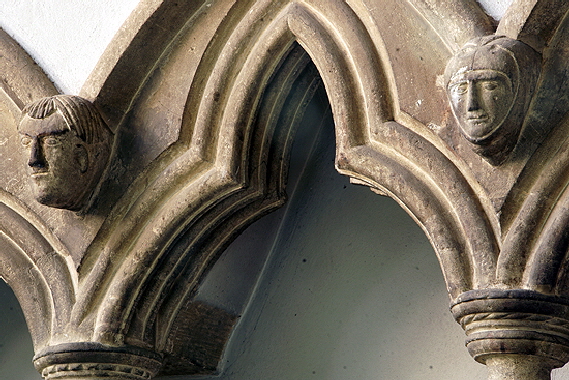 |
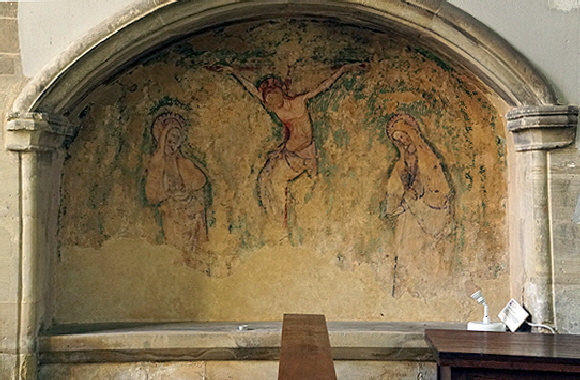 |
|||||||||||||||||||||||||||||||||||||||||||||||||
|
Left: detail of the sedilia, showing sculpture at the spandrels but also some nailhead decoration on on of the colonnettes (right) a sure-fire trope of the Early English - thirteenth century - style. Right: Arguably the biggest treasure in the whole church is this fourteenth century painting of the crucifixion. There are no punches pulled here: Christ is twisted in pain on his cross and the Mary’s wring their hands with anguish. This is a very far cry from how the crucifixion would have been depicted in the first church here. Anglo-Saxon sculpture shows Christ standing in front of his cross, unbowed and triumphant. |
||||||||||||||||||||||||||||||||||||||||||||||||||
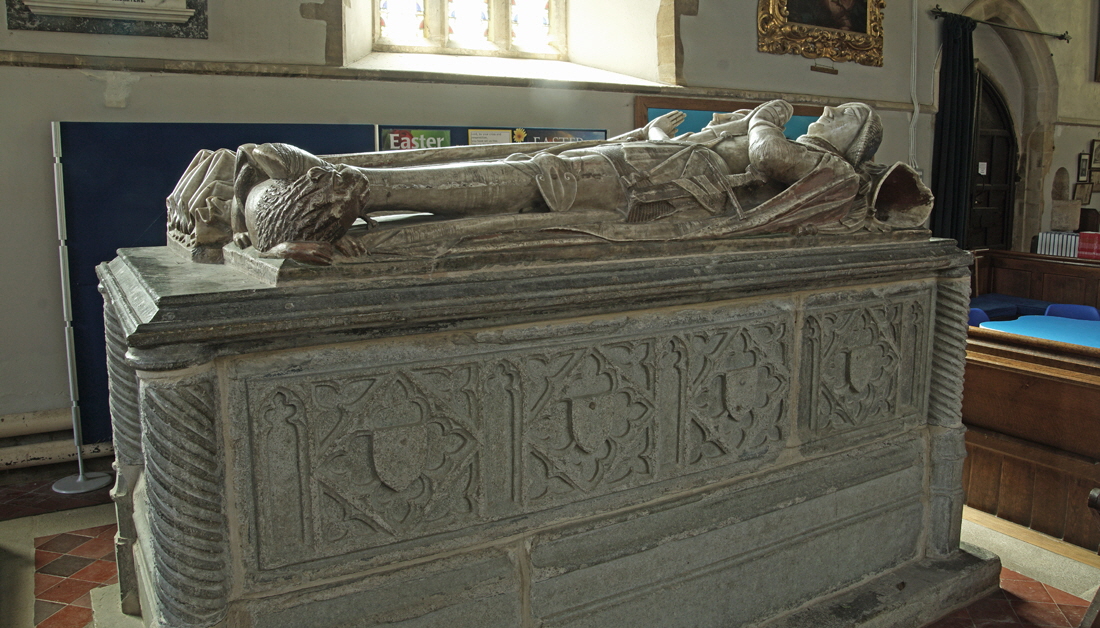 |
||||||||||||||||||||||||||||||||||||||||||||||||||
|
The monument to Sir John Mordaunt (yes, another one!) and his wife, Lady Edith, in the south aisle. This Sir John died in 1506 and was not a lorHe may well, however, have fought alongside henry Tudor at Bosworth Field and was one of Henry’s counsellors. The monument is all in stone. The effigies are, again, in alabaster but this time the tomb chest is of Portland stone. The alabaster is from Chellaston in Derbyshire. |
||||||||||||||||||||||||||||||||||||||||||||||||||
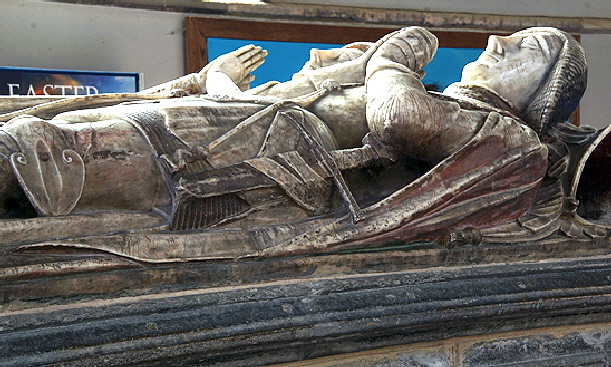 |
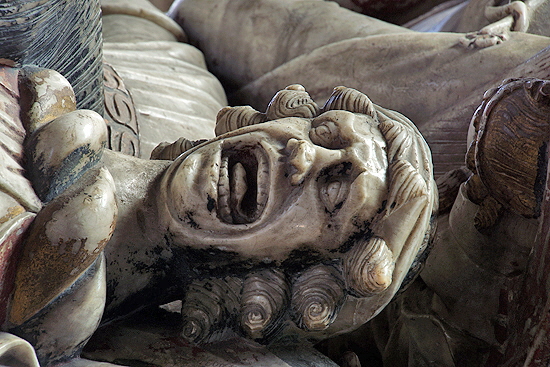 |
|||||||||||||||||||||||||||||||||||||||||||||||||
|
Left: Sir John and his wife. Right: Sir John’s head rests on this “screaming man”. I do not know the meaning here but it is most likely another representation of a “heathen”, He doesn’t look much like a “saracen” - see above - but then he doesn’t look like a fifteenth century Englishman either! |
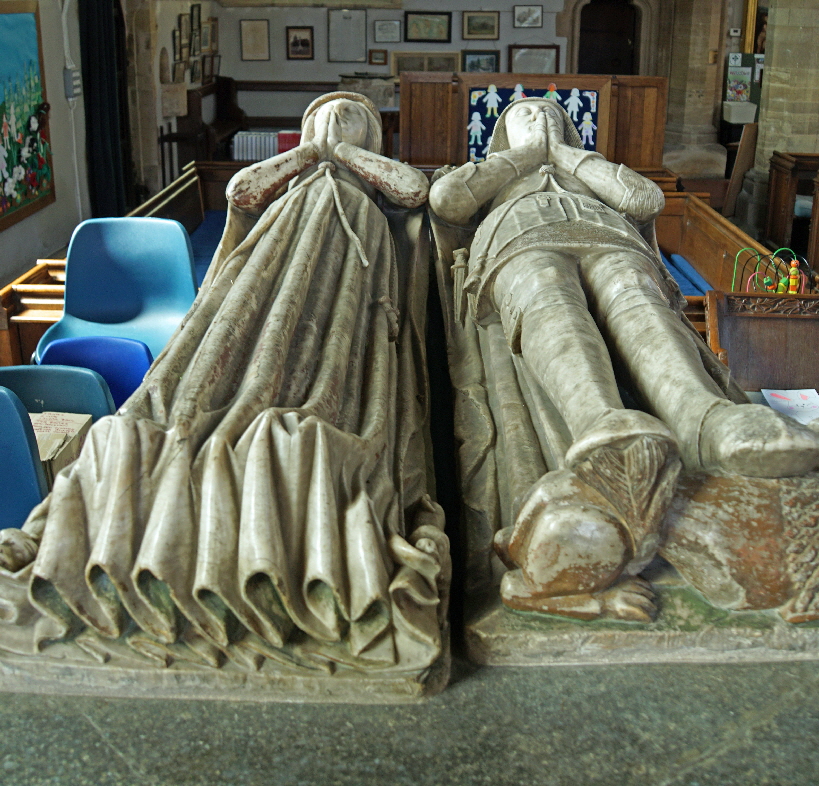 |
|||||||||||||||||||||||||||
|
Note the exquisitely-carved folds of Lady Edith’s dress. Also note that the two figures have clearly been carved separately. |
|||||||||||||||||||||||||||
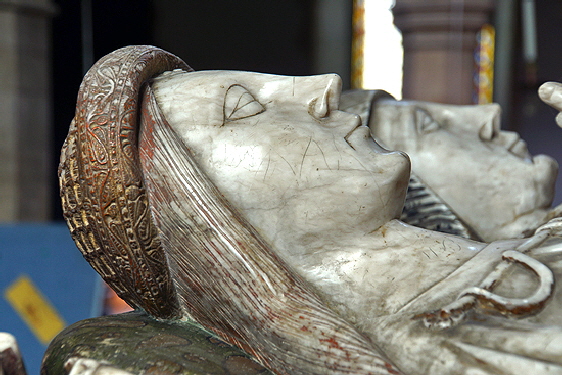 |
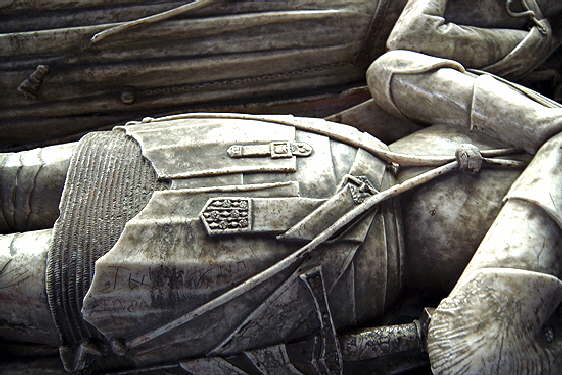 |
||||||||||||||||||||||||||
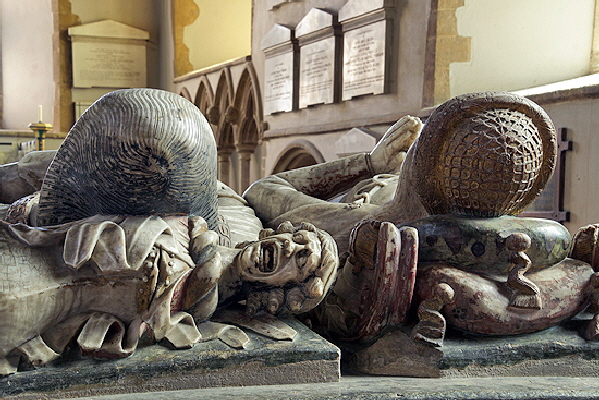 |
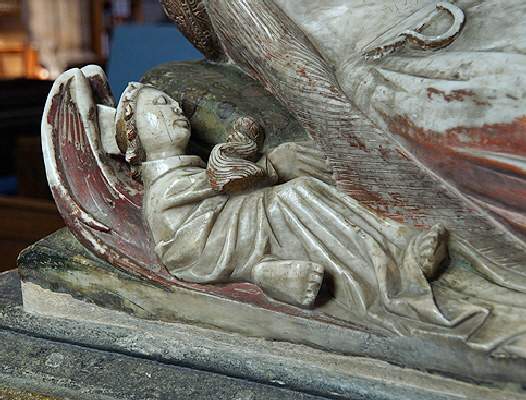 |
||||||||||||||||||||||||||
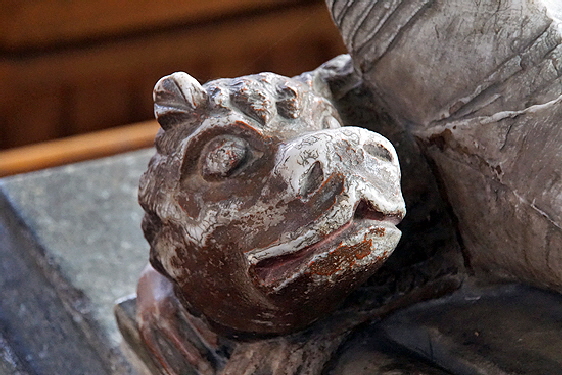 |
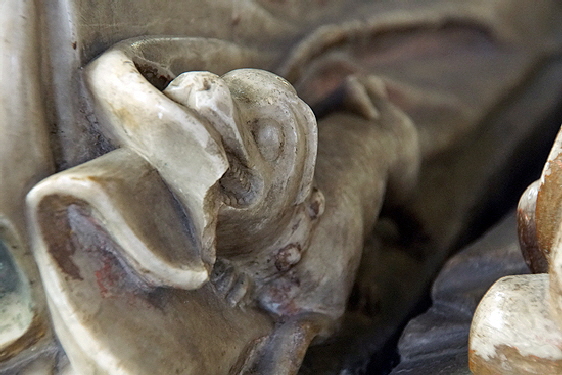 |
||||||||||||||||||||||||||
|
Details from the Sir John Mordaunt monument. Note the exquisitely-carved headdress of Lady Edith (top left). She has angels cushioning her head on both sides (middle left and right). She has a dog chewing at her dress (bottom right) |
|||||||||||||||||||||||||||
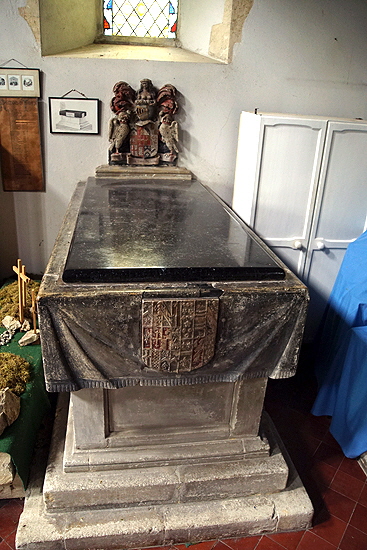 |
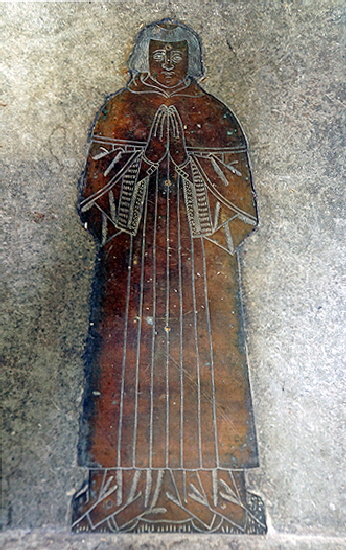 |
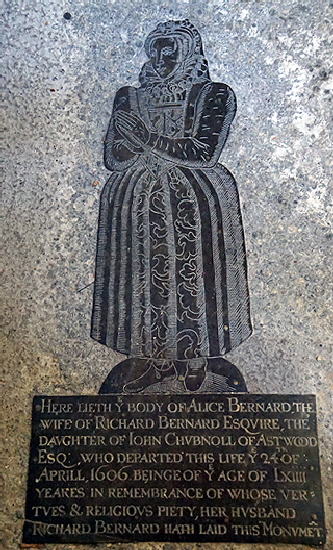 |
|||||||||||||||||||||||||
|
Left: After the three other monuments this onle seems somewhat prosaic. It is for Lewis, third Lord Mordaunt (d.1601). He was a reluctant judge at he trial of mary Queen of Scots. Mind you, that’s what they all said, I reckon, and I suspect most of them meant it. Pevsner called the monument a “rare conceit” which I think he intended as a compliment. A black “cloth” made of stone hangs over the tomb chest. Centre: A brass of about AD1500, commemorating a priest. Right: A brass commemorating Alice Bernard (d.1606). A beguiling warts ’n‘ all representation of a well-loved wife, it seems. |
|||||||||||||||||||||||||||
 |
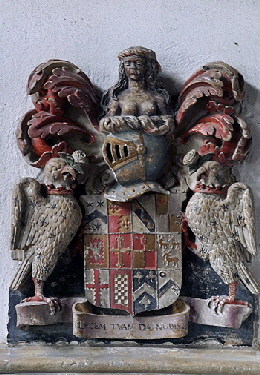 |
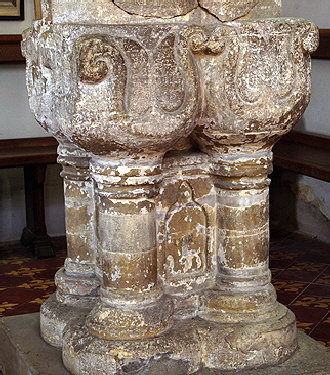 |
|||||||||||||||||||||||||
|
Left: The Lewis Mordaunt monument from the side. What a cluttered church this is, by the way! Centre: The Mordaunt arms at the head of the monument. Right: The Font is very recognisably Early English but Pevsner thinks the base columns look Norman so possibly it all dates from around 1200. |
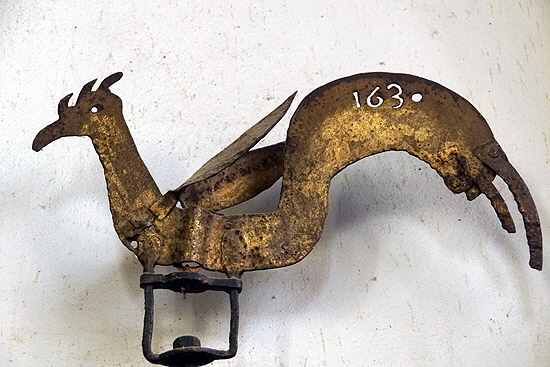 |
 |
|||||||||||||||||||
|
Left: A preserved weather cock of 1630. Why a cock? Well it was intended to remind people of the three times that Simon Peter betrayed Christ in the Garden of Gethsemane. Right: A very nice example of a bier, used to carry a coffin. |
||||||||||||||||||||
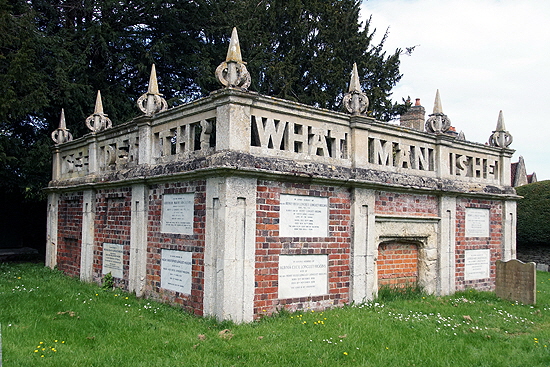 |
||||||||||||||||||||
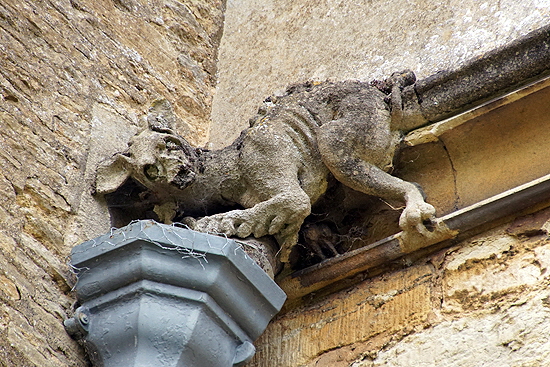 |
||||||||||||||||||||
|
Left: The Victorian mausoleum of the Higgins family. This is also quite a conceit. And I don’t mean it as a compliment! Right: after all those monuments carved by accomplished masters, this one might seem prosaic. But look at it! It has been carved with the cornice from one piece of stone. This as fine a piece an example of the jobbing freemason’s art as you will see for many a mile.. |
||||||||||||||||||||
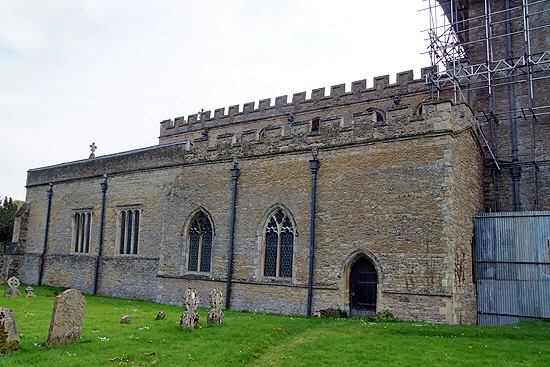 |
||||||||||||||||||||
|
The north side is no more aesthetically pleasing than the south. But this is a treasure house. |
||||||||||||||||||||
|
The Doors of John Leighton |
||||||||||||||||||||
 |
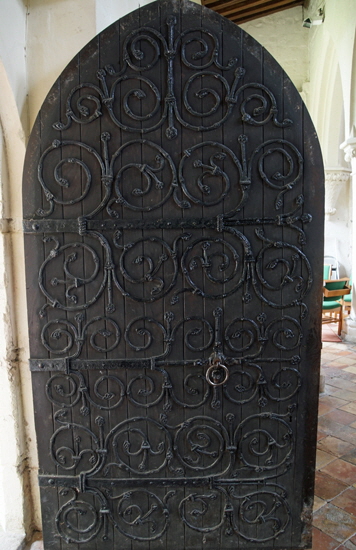 |
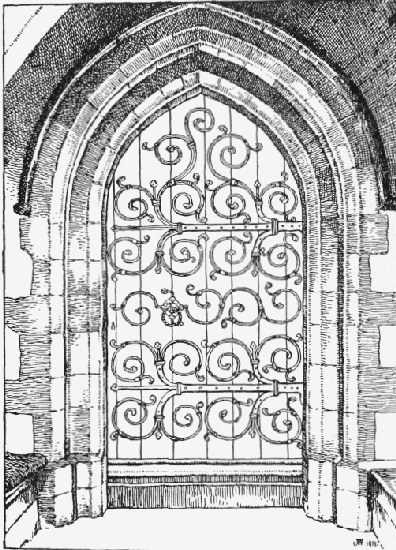 |
||||||||||||||||||
|
Far Left: The door here at Turvey. Centre: The door at Eaton Bray church thirty-one miles away. Right: The door at Leighton Buzzard. twenty five miles from Turvey and six miles from Eaton Bray. |
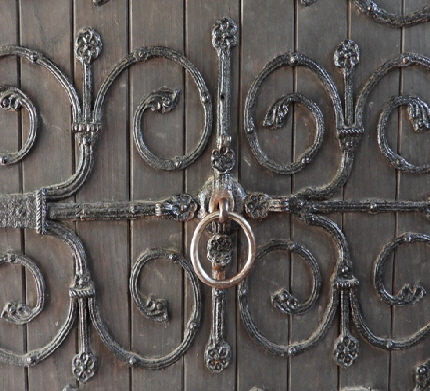 |
|||
|
Door handle, Eaton Bray Church |
|||
|
I hope you have enjoyed this Page and, perhaps, many more besides. Could you help me to make it better still and preserve its future? |
|
|
|
|
You may Download and/or Print this Page in .pdf Format from the icon below. Please note all text and photographs are copyright Lionel Wall and may not be used for any purpose than personal use without my express permission. Email: brumman47@hotmail.com |
|
|
|||
